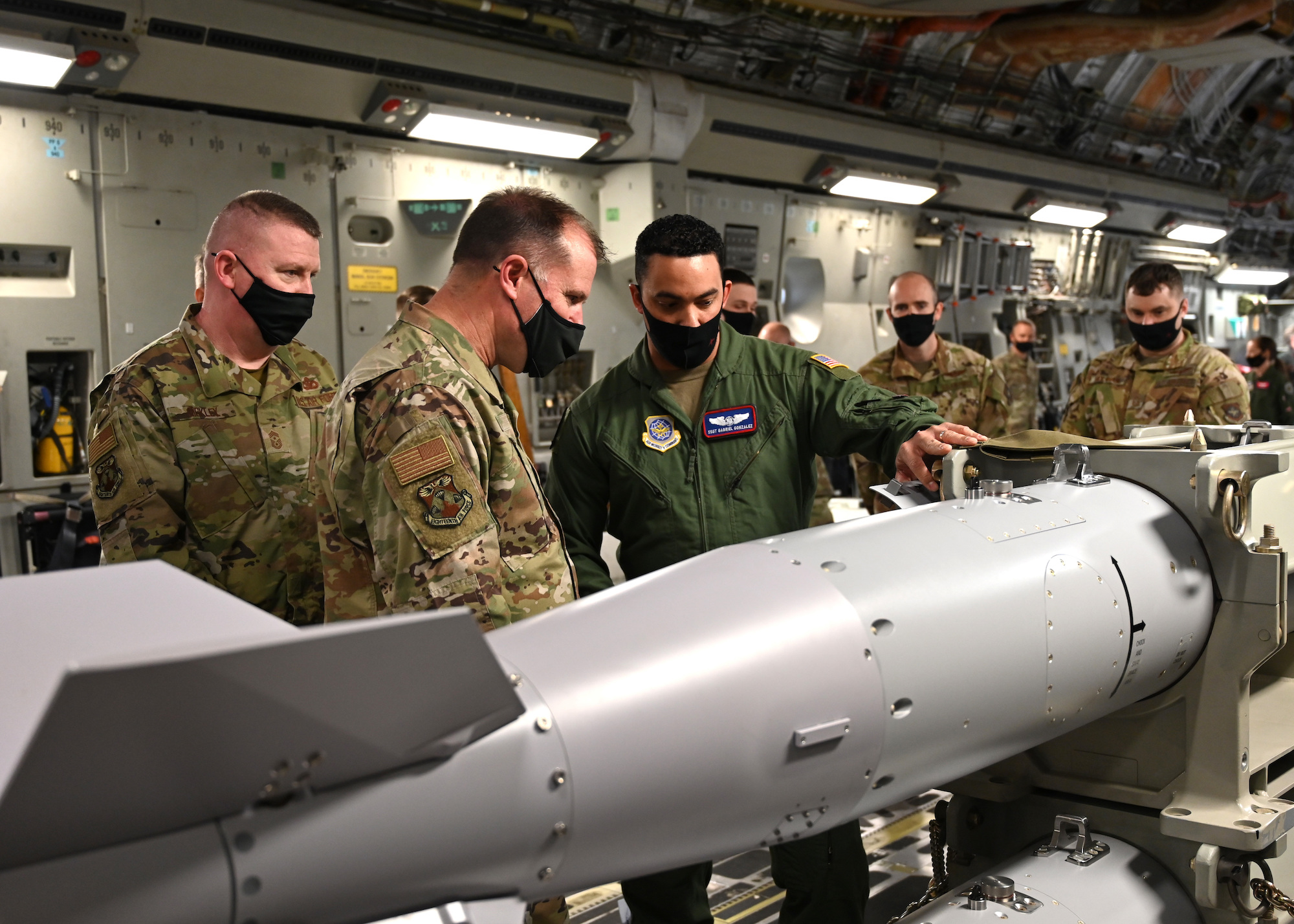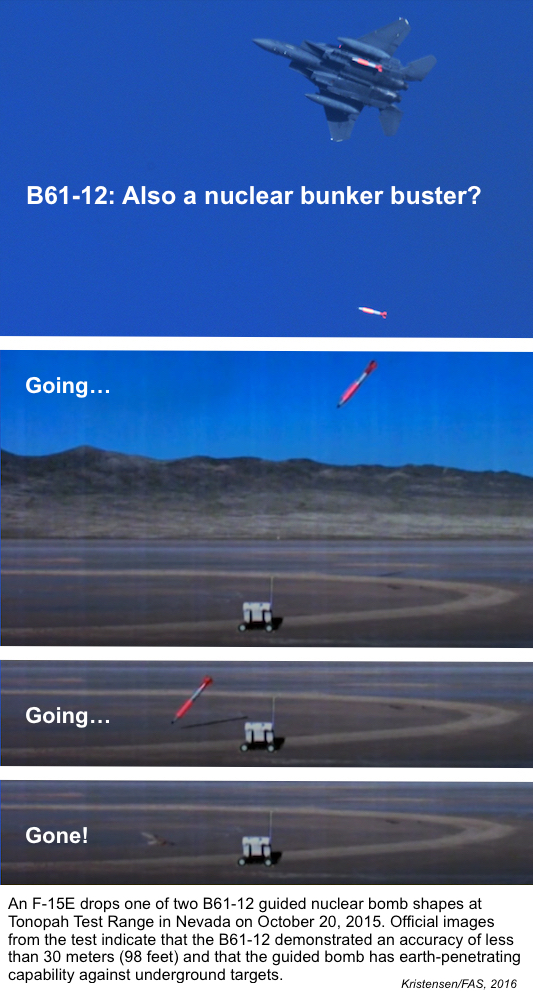
Video Shows Earth-Penetrating Capability of B61-12 Nuclear Bomb

The capability of the new B61-12 nuclear bomb seems to continue to expand, from a simple life-extension of an existing bomb, to the first U.S. guided nuclear gravity bomb, to a nuclear earth-penetrator with increased accuracy.
The National Nuclear Security Administration (NNSA) previously published pictures of the drop test from October 2015 that showed the B61-12 hitting inside the target circle but without showing the bomb penetrating underground.
But a Sandia National Laboratories video made available by the New York Times shows the B61-12 penetrating completely underground. (A longer version of the video is available at the Los Alamos Study Group web site.)
Implication of Earth-Penetration Capability
The evidence that the B61-12 can penetrate below the surface has significant implications for the types of targets that can be held at risk with the bomb. A nuclear weapon that detonates after penetrating the earth more efficiently transmits its explosive energy to the ground, thus is more effective at destroying deeply buried targets for a given nuclear yield. A detonation above ground, in contrast, results in a larger fraction of the explosive energy bouncing off the surface. Two findings of the 2005 National Academies’ study Effects of Earth-Penetrator and other Weapons are key:
“The yield required of a nuclear weapon to destroy a hard and deeply buried target is reduced by a factor of 15 to 25 by enhanced ground-shock coupling if the weapon is detonated a few meters below the surface.”
And
“Nuclear earth-penetrator weapons (EPWs) with a depth of penetration of 3 meters capture most of the advantage associated with the coupling of ground shock.”
Given that the length of the B61-12 is about three-and-a-half meters, and that the Sandia video shows the bomb disappearing completely beneath the surface of the Nevada desert, it appears the B61-12 will be able to achieve enhanced ground-shock coupling against underground targets in soil. We know that the B61-12 is designed to have four selectable explosive yields: 0.3 kilotons (kt), 1.5 kt, 10 kt and 50 kt. Therefore, given the National Academies’ finding, the maximum destructive potential of the B61-12 against underground targets is equivalent to the capability of a surface-burst weapon with a yield of 750 kt to 1,250 kt.
One of the bombs the Pentagon plans to retire after the B61-12 is deployed is the B83-1, which has a maximum yield of 1,200 kt.
Even at the lowest selective yield setting of only 0.3 kt, the ground-shock coupling of a B61-12 exploding a few meters underground would be equivalent to a surface-burst weapon with a yield of 4.5 kt to 7.5 kt.
Implications of Increased Accuracy
Existing B61 versions (B61-3, -4, 7, -10) are thought to have some limited earth-penetration capability but with much less accuracy than the B61-12. The only official nuclear earth-penetrator in the U.S. arsenal, the unguided B61-11, compensates for poor accuracy with a massive yield: 400 kt. The ground-shock coupling of 400 kt, using the National Academies’ finding, is equivalent to the effect of a surface-burst of 6 Megatons (MT) to 10 MT. The B61-11 replaced the old B53, the Cold War bunker buster bomb, which had a yield of 9 MT. The B61-11 can penetrate into frozen soil; it is yet unknown if the B61-12 has a similar capability. Currently there is no life-extension planned for the B61-11, which is not part of NNSA’s so-called 3+2 stockpile plan and is expected to be phased out when it expires in the 2030s.
What makes the B61-12 special is that the B61 capability is enhanced by the increased accuracy provided by the new guided tail kit assembly, a unique feature of the new weapon. The combination of increased accuracy with earth-penetration and low-yield options provides for unique targeting capabilities. Moreover, while the B61-11 can only be delivered by the B-2 strategic bomber, the B61-12 will be integrated on virtually all nuclear-capable U.S. and NATO aircraft: B-2, LRS-B (next-generation long-range bomber), F-35A, F-16, F-15E, and PA-200 Tornado.
How accurate the B61-12 will be is a secret. In an article from 2011 we estimated the accuracy might be on the order of 30-plus meters. Back then no test drop had been conducted and we didn’t have imagery. But now we do.
We cannot see with certainty on the NNSA photo and Sandia video how accurate the November 2015 drop test was. The video and image clearly show the B61-12 impacting the ground well within a large circle. Unfortunately the imagery does not show the full circle and the low angle makes it hard to determine the diameter. But by flipping the image horizontally and combining the copy with the original, the two appear to make a nearly perfect circle. Because we know the length of the B61-12 (11.8 feet; 3.4 meters), it appears the circle has a diameter of approximately 197 feet (60 meters). Since the point of impact is well within circle (roughly one bomb length inside), the B61-12 appears to have hit less than 100 feet (30 meters) from the center of the circle (see analysis of NNSA photo below).

Accuracy of a weapon is expressed as CEP (Circular Error Probability), which is defined as the radius of a circle centered at the target aim-point within which 50% of the weapons will fall. Formally estimating the accuracy of the B61-12 requires more information than the ground zero location of the drop test in the November 2015 event. Even so, the image indicates that at least the November 2015 drop test impacted well within the 30-meter diameter circle.
Little is known in public about the accuracy of nuclear gravity bombs. But information previously released by the U.S. Air Force to Kristensen under the Freedom of Information Act states that drop tests in the late-1990s normally achieved an accuracy of 380 feet (116 meters) for both high- and low-altitude releases and occasionally down to around 300 feet (91 meters) for low-altitude bombing runs.
In other words, although formal and more comprehensive data is missing, the November 2015 drop test indicates a B61-12 performance three times more accurate than existing non-guided gravity bombs.
That increased accuracy and earth-penetration capability will allow strike planners to chose lower selectable yields than are needed with the accuracy of current B61 and B83 bombs to destroy the same targets. Selecting lower yields will reduce the radioactive fallout from an attack, a feature that would make a B61-12 attack more attractive to military planners and less controversial to political decision makers.
Contradictions
The ability of the B61-12 to penetrate below the surface before detonating as seen on the video will further increase the capability against underground targets, especially when combined with the improved accuracy. This opens up a range of options for destroying underground targets with lower selectable nuclear yield settings than with the bombs in the current arsenal. We believe this constitutes an enhanced military capability that is in conflict with the Obama administration’s stated policy not to develop new capabilities for nuclear weapons.
The New York Times article is well written because it captures the contradiction between the denial by some officials (in this case NNSA’s Madelyn Creedon) that the B61-12 has new military capabilities while others (in this case former under secretary of defense for policy James Miller) seem to think it is a good thing that it does.
To that end the article is astute because it quotes the White House pledge not to pursue new military capabilities:
“The United States will not develop new nuclear warheads or pursue new military mission or new capabilities for nuclear weapons.”
…instead of using the Nuclear Posture Review (NPR) Report formulation:
“The United States will not develop new nuclear warheads. Life Extension Programs (LEPs) will use only nuclear components based on previously tested designs, and will not support new military missions or provide for new military capabilities.”
This is important because the NPR formulation is a little less clear and is being used by some officials and defense contractors to argue that the pledge not to pursue new military missions or new military capabilities only refers to the warhead itself and not nuclear weapons in general. That may seem pedantic so the White House statement helps clarify, in case anyone is confused, that the policy indeed applies to “weapons” and not just “warheads.”
The officials who claim the B61-12 will not have new military capabilities say so because the United States already has the capability to hold at risk surface and underground targets, or to the fact that the warhead within the bomb –the so-called “physics package” –remains the same Cold War design. But the combination of increased accuracy and limited earth-penetrating capability allow the B61-12 to threaten below-ground structures with less radioactive fallout. That is a new military capability.
Back in 2011, before the B61-12 development program had progressed to the point of no return, FAS sent a letter to the White House and the Office of the Secretary of Defense pointing out the contradiction with the administration’s policy and implications for nuclear strategy. They never responded.
Worrying about the Bomb
The B61-12 earth-penetration capability may be less than the existing B61-11 earth-penetrator and the accuracy less than a conventional GPS-guided smart bomb, but the Sandia video shows a versatile new weapon that is intended for deployment on both strategic and non-strategic aircraft in the United States and Europe.
Such a capability begs the question of which targets in which countries are envisioned for B61-12 missions, and under what circumstances could use of such a weapon be ordered by the President? The National Academies’ study also found that earth penetration by a nuclear weapon could not contain the effects of the nuclear explosion, and that casualties would likely be the same as if the weapon were detonated at the surface of the earth. These findings particularly speak to the implications of dropping the B61-12 on a bunker located underneath a city.
Moreover, the significant improvements being made to non-nuclear earth-penetrators begs the question why it is necessary to enhance the capabilities of the B61 gravity bomb in the first place.
Both the United State and Russia (and the other nuclear-armed states) have extensive and expensive nuclear force modernization programs underway. What we are seeing today lies somewhere between parallel efforts to refurbish Cold War arsenals and the emergence of a new arms competition fueled by enhancements to existing weapons or production of new or significantly modified types. These enhancements are being developed without nuclear test explosions.
Inevitably the most important capabilities for nuclear deterrent forces are stability, control and safety – daily operational procedures embodying restraint, and strong channels of communication between nuclear weapon states with safeguards against accidental or unauthorized use of nuclear weapons. This area needs a lot of work right now as US-Russian relations continue to fray, already triggering calls from some analysts to further enhance nuclear weapons.
The Sandia video of the B61-12 slipping into the earth like a hot knife into butter doesn’t make the situation better.
* Matthew McKinzie is the nuclear program director at the Natural Resources Defense Council.
The research for this publication was made possible by a grant from the Carnegie Corporation of New York, the New Land Foundation, and Ploughshares Fund. The statements made and views expressed are solely the responsibility of the authors.
Nuclear weapons budgeting is like agreeing to buying a house without knowing the sales price, the mortgage rate, or the monthly payment.
The United States Air Force has forward deployed about one-third of its B-2 stealth bombers to Diego Garcia, or about half the B-2s considered fully operational at any given time.
Over the past year, the campaign to abolish nuclear weapons has experienced numerous wins that were celebrated at the Meeting of State Parties.
China is NOT a nuclear “peer” of the United States, as some contend.
China’s total number of approximately 600 warheads constitutes only a small portion of the United States’ estimated stockpile of 3,700 warheads.